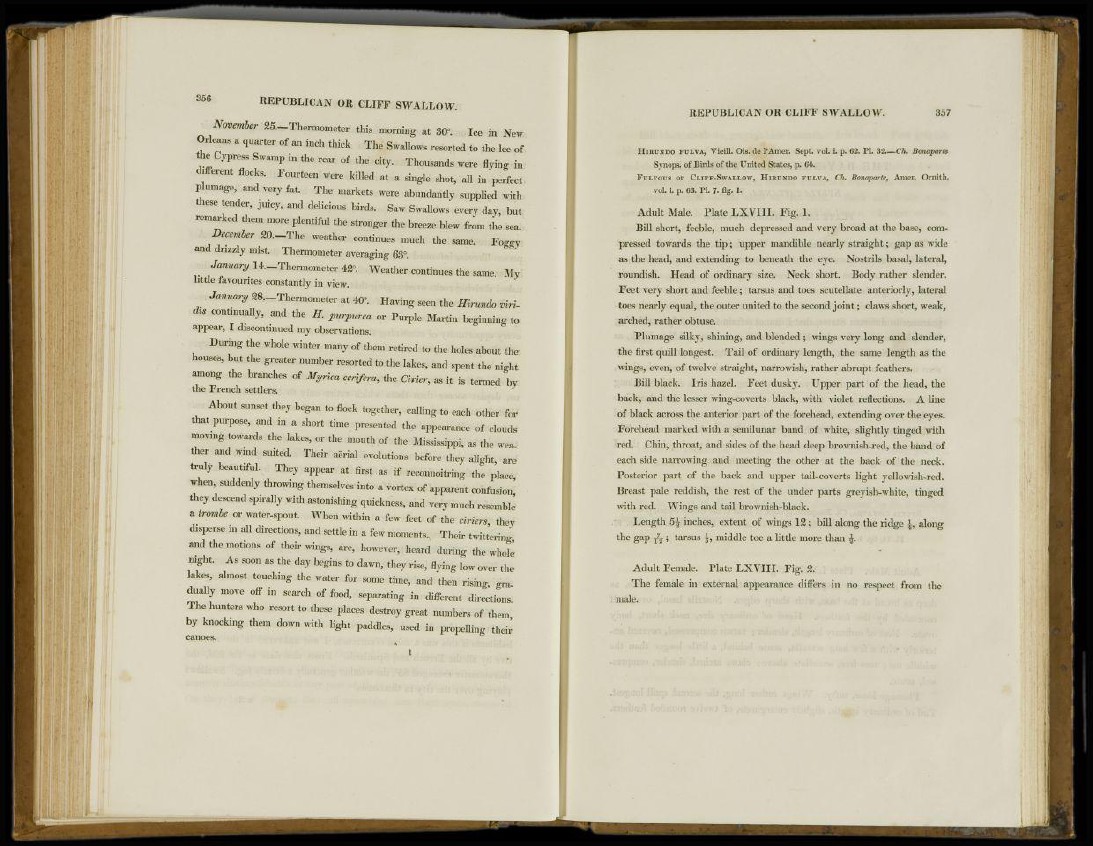
3 5 6 REPUBLICAN O R C L I F F S W A L L O W.
November 25.—Thermometer this morning at 30°. Ice in New
Orleans a quarter of an inch thick The Swallows resorted to the lee of
the Cypress Swamp in the rear of the city. Thousands were flying in
different flocks. Fourteen were killed at a single shot, all in perfect
plumage, and very fat. The markets were abundantly supplied with
these tender, juicy, and delicious birds. Saw Swallows every day, but
remarked them more plentiful the stronger the breeze blew from the sea.
December 20.—The weather continues much the same. Eoggy
and drizzly mist. Thermometer averaging 63°.
January 14.—Thermometer 42°. Weather continues the same. My
little favourites constantly in view.
January 28.—Thermometer at 40°. Having seen the Hirundo viridis
continually, and the H. purpurea or Purple Martin beginning to
appear, I discontinued my observations.
During the whole winter many of them retired to the holes about the
houses, but the greater number resorted to the lakes, and spent the night
among the branches of Myrica cerífera, the drier, as it is termed by
the French settlers.
About sunset they began to flock together, calling to each other for
that purpose, and in a short time presented the appearance of clouds
moving towards the lakes, or the mouth of the Mississippi, as the weather
and wind suited. Their aerial evolutions before they alight, are
truly beautiful- They appear at first as if reconnoitring the place,
when, suddenly throwing themselves into a vortex of apparent confusion,
they descend spirally with astonishing quickness, and very much resemble
a trombe or water-spout. Wrhen within a few feet of the driers, they
disperse in all directions, and settle in a few moments^ Their twittering,
and the motions of their wings, are, however, heard during the whole
night. As soon as the day begins to dawn, they rise, flying low over the
lakes, almost touching the water for some time, and then rising, gradually
move off in search of food, separating in different directions.
The hunters who resort to these places destroy great numbers of them,
by knocking them down with light paddles, used in propelling their
canoes. *
•I r
HIRUNDO FULVA, Vieill. Ois. de l'Amer. Sept. vol. i. p. 62. PI. 32—67». Bonaparte
Synops. of Birds of the United States, p. 64.
FULVOUS or CLIFF-SWALLOW, HIRUNDO FULVA, Ch. Bonaparte, Amer. Ornith.
vol. i. p. 63. PL 7- %• 1.
Adult Male. Plate LXVIII. Fig. 1.
Bill short, feeble, much depressed and very broad at the base, compressed
towards the tip; upper mandible nearly straight; gap as wide
as the head, and extending to beneath the eye. Nostrils basal, lateral,
roundish. Head of ordinary size. Neck short. Body rather slender.
Feet very short and feeble; tarsus and toes scutellate anteriorly, lateral
toes nearly equal, the outer united to the second joint; claws short, weak,
arched, rather obtuse.
Plumage silky, shining, and blended ; wings very long and slender,
the first quill longest. Tail of ordinary length, the same length as the
wings, even, of twelve straight, narrowish, rather abrupt feathers.
Bill black. Iris hazel. Feet dusky. Upper part of the head, the
back, and the lesser wing-coverts black, with violet reflections. A line
of black across the anterior part of the forehead, extending over the eyes.
Forehead marked with a semilunar band of white, slightly tinged with
red. Chin, throat, and sides of the head deep brownish-red, the band of
each side narrowing and meeting the other at the back of the neck.
Posterior part of the back and upper tail-coverts light yellowish-red.
Breast pale reddish, the rest of the under parts greyish-white, tinged
with red. Wings and tail brownish-black.
Length 5 | inches, extent of wings 12; bill along the ridge along
the gap T
7 2 ; tarsus \ , middle toe a little more than \.
Adult Female. Plate LXVIII. Fig. 2.
The female in external appearance differs in no respect from the
male.